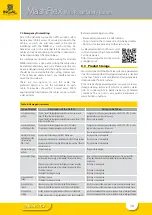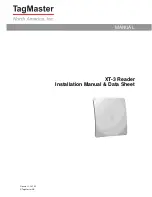
16
Release 07/22
MashFlex
Wire Rope Safety Barrier
Wire Rope Safety Barrier
Wire Rope Safety Barrier
ASH LE
I N G A L C I V I L P R O D U C T S
ASH LE
I N G A L C I V I L P R O D U C T S
7.4 Emergency Dismantling
Due to the dynamic nature of a traffic accident, safety
barriers may inhibit access of rescue personnel to the
vehicle, or crash site, and may need to be moved.
Interfering with the WRSB at a crash site may be
hazardous due to the potential latent tension in the
cables and all de-tensioning should be conducted by
trained personnel at the tension bays.
In an emergency situation, where waiting for a trained
WRSB install crew is not viable, cutting the cables may
be deemed absolutely necessary. Please note, this can
be a very dangerous task and a thorough risk assessment
should be conducted before the cutting commences.
If the cables are under tension, any interference may
cause them to release.
There are two options to cut the cable, the
preferred option is to cut the turnbuckle on each
cable. Turnbuckles should be located every 300m
approximately. Alternatively, the cables can be cut with
a disc grinder.
Before commencing any cutting:
• Ensure all personnel are in a safe location.
• Do not stand on the concave side of restrained cables.
• Do no cut in close proximity to the crash scene.
A video demonstration of how to work
with, and around, high tension WRSB
can be viewed at:
https://www.ingalcivil.com.au/wrsb-
emergency-cut.
8.0 Product Storage
Most components of the MashFlex system are galvanized
steel. It is important that stored galvanized work is stacked
so that each item is well ventilated and can adequately
drain rainwater from its surfaces.
Poor storage of galvanized product can give rise to wet
storage staining (white rust) which is caused by water
(rain or condensation) in badly drained or ventilated
conditions. This can occur very quickly, particularly in
warm, humid conditions.
Table 6: Damage Assessment
Type of Defect
Description of the Defect
Action to be Taken
Galvanizing damage
on Posts.
The sum total of the damaged or uncoated areas does not exceed
10cm
2
(0.5% of the total surface area).
The sum total of the damaged or uncoated areas exceeds 10cm
2
(0.5%
of the total surface area).
An organic zinc rich epoxy paint, complying with AS/NZS 3750.9, is to be
applied to the repair areas in two coats.
The post is to be replaced.
Galvanizing Damage
on Wire Rope Cable
The wire rope is nicked or gouged to less than 10% depth.
The wire rope is nicked or gouged greater than 10% depth.
An organic zinc rich epoxy paint, complying with AS/NZS 3750.9, is to be
applied to the repair areas in two coats.
The wire rope section is to be replaced.
Mechanical Damage
on Wire Rope Cable
(Refer drawing
WR-STD-59)
Any rope length containing more than 1 broken wire.
Any rope where the diameter is reduced by more than 10% by abrasion.
Any rope which has been crushed or flattened by more than 10% of its
nominal diameter.
The rope section is to be replaced.
The rope section is to be replaced
The rope section is to be replaced.
Mechanical damage
on Posts.
The post is distorted.
The post is to be replaced.
Damaged End Fitting
There is damage to the thread of the fitting, however tension can be
maintained in the wire rope system without relying on the fitting.
There is damage to the thread of the fitting and tension cannot be
maintained in the wire rope system without relying on the fitting.
The fitting is cracked.
The body of the fitting is distorted.
There is no requirement for immediate replacement. The location of the
fitting should be noted and scheduled for replacement during routine
maintenance.
The fitting is to be replaced.
The fitting is to be replaced.
The fitting is to be replaced.
Damaged Tension
Fitting
The fitting is cracked.
The body of the fitting is distorted.
The fitting is to be replaced.
The fitting is to be replaced.
Damaged Driven
Sleeve
Sleeve opening is significantly distorted from yielding post.
Sleeve is dislocated causing new post to be out of alignment.
Install a new sleeve 200mm upstream or downstream of damaged sleeve.
Install a new sleeve 200mm upstream or downstream of damaged sleeve.
Damaged Post
Footing
Footing cracked causing replaced post to be out of alignment.
Footing is dislocated causing replaced post to be out of alignment.
Install a new footing 200mm upstream or downstream of damaged footing.
Install a new footing 200mm upstream or downstream of damaged footing.
Содержание INGAL MashFlex MASH TL3
Страница 11: ...11 Release 07 22 MashFlex Wire Rope Safety Barrier Figure 10 Figure 11 Figure 12 Figure 13...
Страница 12: ...12 Release 07 22 MashFlex Wire Rope Safety Barrier Figure 14 Figure 15 Figure 16 Figure 17...
Страница 19: ...19 Release 07 22...
Страница 26: ...26 Release 07 22 Notes...
Страница 27: ...27 Release 07 22 Notes...













































